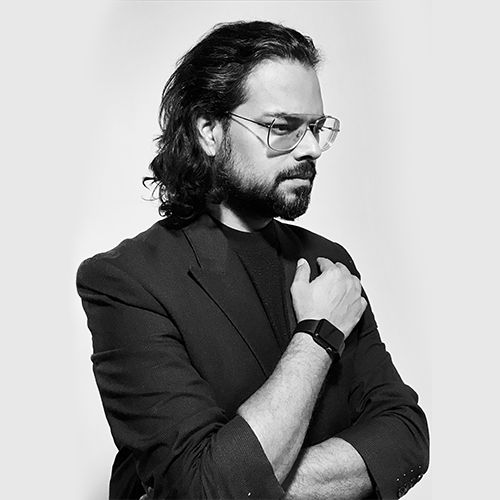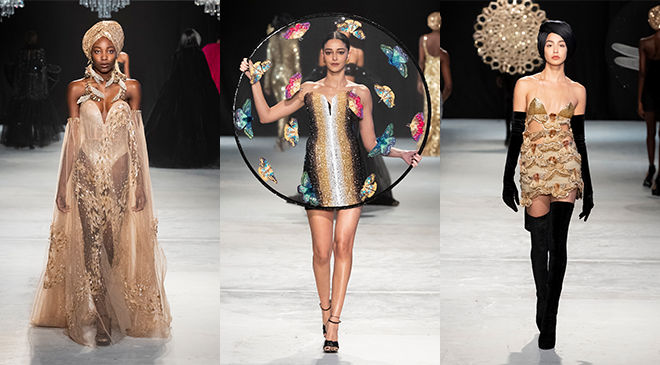
Rahul Mishra
Founder
Label - Rahul Mishra
There is much to anticipate from the Rahul Mishra brand in the coming years
Rahul Mishra is renowned for his commitment to slow fashion and the preservation of traditional Indian crafts. As the first Indian designer to showcase at the Paris Haute Couture Week, Mishra’s eponymous label stands as a beacon of sustainability and empowerment within the industry. In a conversation with Fibre2Fashion, Founder Rahul Mishra emphasises the importance of creating something truly unique in the fashion world, offering more accessible fashion options to ensure everyone can enjoy wearing their creations.
Fibre2Fashion: Could you describe the defining moment or experience that set you on the path to becoming a renowned fashion designer?
Rahul Mishra:
I believe that the path towards anything is always a work in progress, shaped not by one or two moments, but by a combination of day-to-day events. These events, comprising both successes and failures, come together to culminate in achievements. One pivotal aspect of my journey was my design education, which began at the National Institute of Design in Ahmedabad. Additionally, completing my graduate degree in science significantly aided me as a designer.
F2F: Where do you primarily draw inspiration from, when creating your designs? How would you define the aesthetics of your overall work?
RM:
For most of the collections, I draw inspiration from our surroundings — mundane forms of nature, whether it is the stars, the depths of water, or a leaf unfolding in a planter. Nature’s abundance is present in every nook and corner around us, making it a profound source of inspiration. It is a divine gift from God that consistently fuels our creativity. Beyond nature, man-made forms like buildings and geometric structures have also been inspirational in my work.
F2F: What inspired the creation of your latest couture collection, ‘Superheroes’, and how do you maintain a balance between innovation and wearability in your designs?
RM:
The inspiration behind our latest couture collection, ‘Superheroes,’ stems from a deeply personal experience while building a house in the Himalayan region of Uttarakhand, situated in front of a protected biodiverse forest. Over the past year, my interactions with the surrounding environment led to fascinating encounters with a myriad of creatures, from palm-sized moths to enchanting fireflies. These experiences, whether shared with my daughter during leisurely walks or captured in videos, underscored the intricate ecosystem of insects coexisting within our living spaces.
F2F: Your brand is known for supporting sustainable livelihoods for over 1,000 artisans. Could you elaborate on how exactly your brand supports and empowers these communities?
RM:
Since the very beginning, Divya (my wife) and I have been unwavering in our commitment to our core philosophies and primary goals. One of these is our dedication to supporting our own handicraft and design values. The painstakingly slow process of hand-weaving and hand embroidery allows us to build sustainable livelihoods for more than 1,000 artisans.
F2F: In what ways do you believe luxury brands can adopt more sustainable and participatory practices without compromising their brand image?
RM:
Luxury brands can indeed embrace sustainable and participatory practices without compromising their brand image by recognising these principles as valuable assets rather than compromises. In our case, we prioritise sustainability and participatory practices as core aspects of our brand identity.
F2F: Can you take us back to the moment when you decided to launch the AFEW brand? What was the driving force behind this decision?
RM:
AFEW, co-owned by Divya and me, in partnership with Reliance Brands Limited, represents a dream fulfilled on a global scale. Our journey began as a ready-to-wear brand before ascending to the prestigious stage of Haute Couture Week, creating numerous pieces for Rahul Mishra Couture. This venture feels like coming full circle, allowing us to craft something truly unique in the fashion world.
F2F: Who are some of your biggest design influences, both within and outside of the fashion industry?
RM:
My creative influences are diverse. While I deeply admire the work of renowned designers, my inspirations extend far beyond the realm of fashion. I hold great appreciation for the work of many creative minds and what they have contributed to the world. However, my all-time favourite figures aren’t restricted to designers. For instance, I deeply engage with the philosophies and quotes of Steve Jobs. I am also captivated by the art history that Miyazaki incorporates into his movies. Similarly, the way Christopher Nolan portrays cinema as an art form has a significant impact on me.
F2F: What have been the biggest challenges you have faced as a designer, and how have you overcome them?
RM:
Every season, we embark on a creative journey from ground zero. It’s the beauty of creating something new — no preconceived ideas, no set thought processes. We explore 2-3 concepts simultaneously, fleshing out the ideas until we streamline them into one powerful theme that guides our entire creative process. Sometimes, we face creative blocks, especially when starting from scratch. The challenge lies in not knowing where or how to begin. There are instances when powerful ideas emerge, but internal conviction is lacking. In a nutshell, the process is very organic, driven by multiple ideas but constrained by time.
F2F: Being the first Indian designer to showcase at the Paris Haute Couture Week is a significant achievement. How has this platform influenced your approach to fashion and sustainability?
RM:
Being featured on the Haute Couture calendar is an immense privilege for our brand. The opportunity to showcase the concept of slow fashion and the couture that India can offer has been a significant milestone. In 2020, I had the honour of becoming the first Indian designer to participate in the haute couture calendar. I found myself asking why it took until 2020 for a talent from India to be recognised on this platform.
F2F: How do you see the future of Indian fashion evolving, both domestically and on the global stage?
RM:
The future of Indian fashion is incredibly promising, both domestically and on the global stage. I believe that building a successful fashion brand requires a long-term approach that balances creativity with business acumen. It is essential to focus on growing retail presence while simultaneously investing in strong brand building. Creating lasting impact in the fashion industry requires more than just a fleeting moment of attention. Consistent innovation and surprise are key to capturing and retaining audience interest. Having a clear brand purpose is not only beneficial but essential for achieving significant success.
F2F: Are there any upcoming projects or developments that you are particularly excited about?
RM:
There is much to anticipate from the Rahul Mishra brand in the coming years, particularly with the recent launch of our ready-to-wear label in partnership with RBL. We have introduced easy-to-wear menswear, womenswear, and accessories such as bags and shoes, among other offerings. Additionally, we have some exciting brand collaborations in the pipeline. Furthermore, our retail footprint is set to expand dramatically in the next few years, with plans to open multiple large-format retail outlets in India, Europe, the Middle East, and the US.
F2F: What do you consider to be your greatest achievement(s) in your career so far?
RM:
I have been incredibly fortunate to witness several achievements in our career. For both Divya and me, it has been an emotional journey filled with surprises, hard work, passion, and the human spirit. Whether it was receiving the Woolmark prize in 2014, starting our ready-to-wear collection in 2014, or debuting at Haute Couture in Paris, each milestone holds profound significance. The entire concept behind the brand, the thought process, everything somehow culminates into beautiful poetry. I genuinely believe that this journey will mark a defining moment, representing the culmination of all our efforts in building a global ready-to-wear brand with a strong aesthetic and deeply rooted DNA. It also reflects our vision of a modern India.
F2F: What advice would you give to aspiring fashion designers, particularly those from India?
RM:
Aspiring fashion designers should embrace the wealth of resources available to them, champion craftsmanship, and seize opportunities to contribute to and learn from India’s rich handloom tradition. My advice for young design students is:
- Take advantage of the accessibility to information about handloom textiles, including their purpose, production processes, and the skilled artisans behind them. Design colleges are increasingly emphasising the craftsmanship of handlooms, encouraging students to centre their projects around this rich heritage.
- Acquire fundamental technical knowledge of garment construction. This knowledge is indispensable for aspiring fashion designers, whether it is obtained from design schools, workshops, or personal study. In today’s digital age, there is a plethora of information available, empowering designers to make informed choices and understand concepts like sustainability.
- Explore opportunities for collaboration and engagement with handloom artisans. These opportunities have expanded through trade fairs, events like Paramparik Karigars, and exhibitions. These platforms not only allow designers to showcase their work but also facilitate learning, purchases, and partnerships with artisans. This renewed focus has sparked a surge of interest among young designers, who are eager to explore and contribute to the handloom tradition through their creations. Crafting pieces that resonate with their brands while also supporting artisan communities has become a priority.
F2F: Suggest five style tips to slay in any outfit and on any occasion.
RM:
Five style tips to slay in any outfit and on any occasion:
- Embrace your individuality by celebrating your unique style and personality.
- Prioritise comfort and confidence by avoiding anything that detracts from them, focusing instead on pieces that make you feel great.
- Be true to your taste; wear what resonates with you and reflects your authentic self, rather than following trends blindly.
- When planning your outfit, consider the activities and environment of the event, opting for appropriate attire that allows you to move freely and comfortably.
- And lastly, remember that a genuine smile is the ultimate accessory that completes any outfit.
F2F: Looking ahead, what are your aspirations for the future of your brand and its impact on the fashion industry?
RM:
Looking ahead, our aspirations for the future of both Rahul Mishra Couture and AFEW Rahul Mishra are ambitious and multifaceted. Over the next few years, we aim to enhance the brand experience for our audience by reshaping perceptions and deepening engagement. Specifically for our couture label, we foresee significant growth and expansion in terms of retail presence and creative output. Additionally, we plan to diversify into new product verticals, leveraging the strengths and ethos of the Rahul Mishra brand. Central to our vision is a commitment to furthering our engagement with craftsmen and artisans, fostering meaningful collaborations, and driving positive impact within the fashion industry.

Aseem Prakash
Anurag Batra
Rahul Mehta
Fanny Vermandel
Gabi Seligsohn
Bill D’Arienzo
Arun Sirdeshmukh
Abhay Gupta
Pradip Mehta
Rahul Mehta





_8.JPG)







